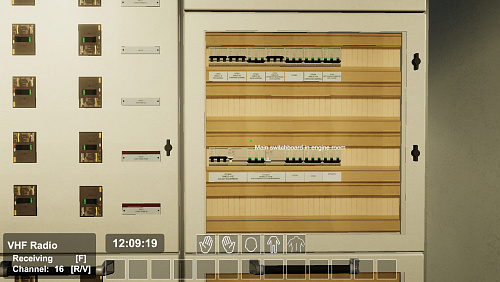Purpose
GDS Simulator is intended for practical training in using portable gas detectors for testing atmosphere in ship enclosed spaces.
Configuration
Simulator consists of Instructor WorkPlace (IWP), and Student WorkPlaces (SWP).
IWP is designed to set and control the performance of training tasks.
Instructor’ operations:
GDS Simulator includes Dräger X-am 5000 portable gas detector, which is widely used on ships, in accordance with its Technical Manual. Gas detector simulator helps determining concentration of O₂, explosive gases and vapours (% LFL), H₂S and CO for maintaining tests, required for enclosed space entry.
Simulator includes the following ship spaces:
Testing atmosphere in the cargo tank:
1. Automatic check/calibration of the gas detector at the calibration station.
2. Connecting gas pump.
3. Gas detecting through the vapour lock.
4. Sending the measurement results to the instructor's workplace.
Testing atmosphere in the paint store:
1. Connecting gas pump.
2. Gas detecting through the hole.
3. Sending the measurement results to the instructor's workplace.
4. View the report on the exercise at the instructor's workplace.
Testing atmosphere in CO2 station room:
1. Turning off ventilation in the room.
2. Connecting gas pump.
3. Gas detecting through the hole.
4. Sending the measurement results to the instructor's workplace.
5. View the report on the exercise at the instructor's workplace.
Automatic check/calibration of the gas detector at the calibration station. The video shows how to work with an operable and faulty device.
GDS Simulator is intended for practical training in using portable gas detectors for testing atmosphere in ship enclosed spaces.
Configuration
Simulator consists of Instructor WorkPlace (IWP), and Student WorkPlaces (SWP).
IWP is designed to set and control the performance of training tasks.
Instructor’ operations:
- to assign a closed space to the student;
- to enter type and concentration of gases and vapours in the enclosed spaces;
- to compare the measurements results made by the student with those given.
- to study construction, indications and controls of the gas detector;
- to study gas detector calibration principles and prepare it for operation;
- to determine the type and percentage of gases in the enclosed space.
GDS Simulator includes Dräger X-am 5000 portable gas detector, which is widely used on ships, in accordance with its Technical Manual. Gas detector simulator helps determining concentration of O₂, explosive gases and vapours (% LFL), H₂S and CO for maintaining tests, required for enclosed space entry.
Simulator includes the following ship spaces:
- Cargo tank with vapour lock for gas detector hose penetration;
- Ballast Tank with hatch lids for gas detector hose penetration;
- CO₂ station;
- Paint store.
- during tankers personnel training courses in accordance with requirements of Chapter V of SCTW Code;
- during Advanced Fire Fighting Training courses in accordance with requirements of Chapter VI of SCTW Code;
- during Enclosed Space Entry training courses.
Simulator can be used:
Delivery set
Simulator can be delivered as a separate product, or as part of AFS Advanced firefighting simulator.
Testing atmosphere in the cargo tank:
1. Automatic check/calibration of the gas detector at the calibration station.
2. Connecting gas pump.
3. Gas detecting through the vapour lock.
4. Sending the measurement results to the instructor's workplace.
Testing atmosphere in the paint store:
1. Connecting gas pump.
2. Gas detecting through the hole.
3. Sending the measurement results to the instructor's workplace.
4. View the report on the exercise at the instructor's workplace.
Testing atmosphere in CO2 station room:
1. Turning off ventilation in the room.
2. Connecting gas pump.
3. Gas detecting through the hole.
4. Sending the measurement results to the instructor's workplace.
5. View the report on the exercise at the instructor's workplace.
Automatic check/calibration of the gas detector at the calibration station. The video shows how to work with an operable and faulty device.
Legislation
STCW Code:
STCW Convention:
- Section A-V, Table A-V/1-1-3 - Specification of minimum standard of competence in advanced training for chemical tanker cargo operations
- Section A-V, Table A-V/1-2-1 - Specification of minimum standard of competence in basic training for liquefied gas tanker cargo operations
- Section A-V, Table A-V/1-2-2 - Specification of minimum standard of competence in advanced training for liquefied gas tanker cargo operations
- Section A-VI, Table A-VI/1-2 - Specification of minimum standard of competence in fire prevention and fire fighting
STCW Convention:
- Regulation V/1-1
- Regulation V/1-2
- Regulation VI/1
- Regulation VI/3



























